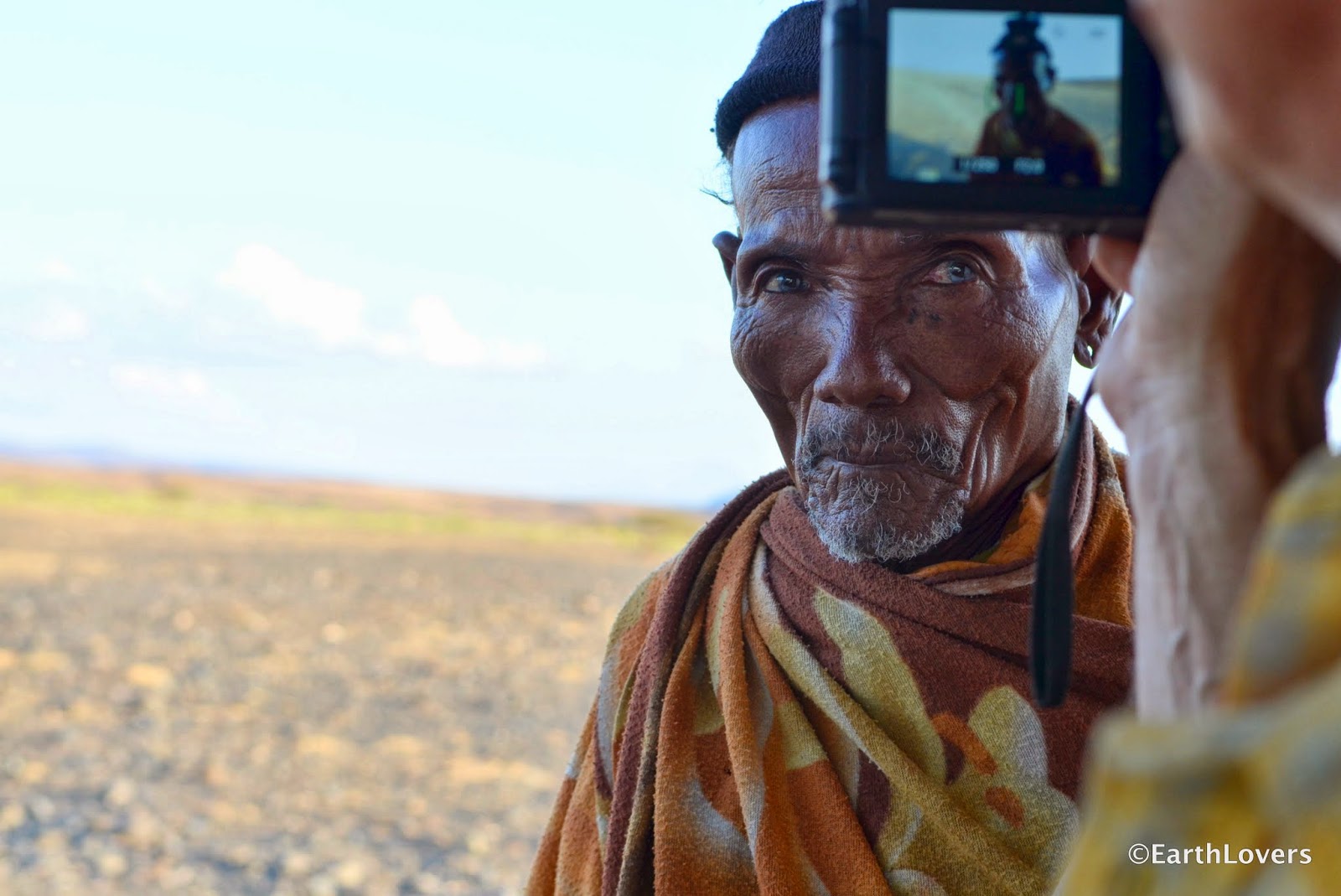 |
| Topis wandering along the Lake Turkana Topis ziehen am Ufer des Lake Turkana entlang |
 |
| Flamingos feeding in Lake Turkana Flamingos bei der Nahrungssuche im Lake Turkana |
 |
| Encounter with an old fisherman, near to Loiyangalani Begegnung mit einem alten Fischer, kurz vor Loiyangalani |
If you are following our blog, you already know: the Lake Turkana in the northwest of Kenya is said to be most inhospitable, since it is hot, dry and much windy. The route along the lake is full of pitfalls (s. our post Lake Turkana Route: Infamous, and Justifiable So). Yet we are thrilled about our time here. The terrific volcanic landscape is fascinating, as well as the view onto the lake, which is also referred to as the Jade Sea due to the remarkable turquoise colour of its water. It is no coincidence that the Lake Turkana National Parks are now listed as a UNESCO Heritage Site.
Death of Lake Turkana near?
However, the world's largest permanent desert lake has a problem: the water level is dropping since the evaporation is higher than the inflow. To make things worse, Gibe III in Ethiopia is under construction. This is a dam with a power plant on the Omo river, Lake Turkana's main water source. Prominent figures such as paleoanthropologist and conservationist Richard Leakey are taking a stand for the lake, and international organizations have already called for protests against Gibe III. Let's hope the protests last and are loudly enough to save the endangered eco-system in the region as well as the livelihood of at least 300,000 Kenyans and further 200,000 indigenious people in Ethiopia concerned by this project.
More information about this threat you find e.g. here:
the Star "Death Of Lake Turkana Near - New Report"
Business Daily "Ethiopia Dam threatens Lake Turkana, says expert"
International Rivers "Ethiopian Dam Threatens to Turn Lake Turkana into 'East Africa's Aral Sea'"
Earth Tribe "Ikal Angelei and protecting Lake Turkana"
The New York Times "To Fight a Dam, Rather Than 'Live on Your Knees'"
Friends of Lake Turkana
Gilgel Gibe III Dam
 |
| A whirlwind in the distance Sieht aus, als ob ihr der Kopf raucht. Aber wie gesagt: Sieht nur so aus... |
 |
| Woohoo! The first rain for a long time. Nature is taking a deep breath, we too. Hurra! Der erste Regen seit langem. Die Natur genießt es. Wir auch. |
 |
| Chestnut-bellied sandgroose Braunbauch-Flughuhn (was für ein Name für so ein schönes Tier) |
 |
| This waran is at least 1.5 m long Dieser Waran ist mindestens 1,5 m lang |
Lake Turkana, Kenias Jadesee
Wenn ihr unseren Blog verfolgt, wisst ihr ja schon: der Lake Turkana im Nordwesten Kenias gilt als äußerst unwirtlich, weil heiß, trocken und sehr windig. Die Strecke entlang des Sees ist nicht ohne Tücken (s. unseren Post Lake Turkana Route: berühmt berüchtigt, und völlig zu Recht). Dennoch sind wir von unserem Aufenthalt hier völlig begeistert. Die grandiose vulkanische Landschaft ist faszinierend, ebenso auch immer wieder der Blick auf den Jadesee, so genannt wegen seiner bemerkenswerten türkisen Farben. Nicht von ungefähr zählen die Lake Turkana Nationalparks inzwischen zum UNESCO Weltkulturerbe.
Lake Turkana bald tot?
Der größte permanente Binnensee der Welt hat allerdings ein Problem: Sein Wasserspiegel nimmt ab und er versalzt immer weiter, da hier mehr Wasser verdunstet als hinzufließt. Es kommt jedoch noch schlimmer. Denn in Äthiopien wird derzeit Gibe III gebaut. Das ist ein Staudamm mit einem Wasserkraftwerk, und zwar am Fluß Omo, dem einzigen bedeutenden Wasserzufluß des Lake Turkana. Prominente Persönlichkeiten wie der Paläoanthropologe und Umwelt- & Naturschützer Richard Leakey setzen sich für den Lake ein, und internationale Organisationen haben schon zum Protest gegen Gibe III aufgerufen. Hoffen wir mal, dass diese Proteste auch andauern und lautstark genug sind, um das Ökosystem in der Gesamtregion ebenso wie die bedrohte Lebensgrundlage von mindestens 300.000 betroffenen Kenianern und weiteren 200.000 Indigenen in Äthiopien zu erhalten.
Weitere Informationen hierzu findet ihr u.a. hier:
Spiegel Online " Staudammbau in Äthiopien: Tödlicher Fortschritt am Turkana-See"
Survival International "Mega-Staudamm gefährdet 200.000 Indigene in Äthiopien"
Gilgel Gibe III
 |
| Soon clouds obscure the sun... Die Wolken verdecken gleich die Sonne... |
 | |
| ... but disappear only one minute after the full solar eclipse... ... verziehen sich aber wieder eine Minute nach der totalen Sonnenfinsternis... |
 |
| ... still revealing views of the rare natural spectacle. ... und geben doch noch einen Blick auf das seltene Naturspektakel frei. |
 |
| A quick deal with the tourists, usually they are coming just rarely in this remote area. Schnell noch ein kleines Geschäft mit den Touristen, sie kommen sonst eher selten in die abgelegene Region. |
 |
| .... here a homo sapiens admires the view from the roof of our camper into the distance. ... hier bewundert ein homo sapiens die Aussicht vom Dach unseres Campers in die weite Ferne. |
 |
| Natural beauty in Ileret Naturschönheit in Ileret |
 |
| We continue along the Lake Turkana... Und weiter geht's entlang des Lake Turkana... |
 |
| ... the route seems to be endless ... die Strecke scheint endlos zu sein |
 |
| We did it! Here we leave at least the Sibiloi National Park behind. Geschafft! Hier lassen wir zumindest schon einmal den Sibiloi National Park hinter uns. |












Keine Kommentare:
Kommentar veröffentlichen